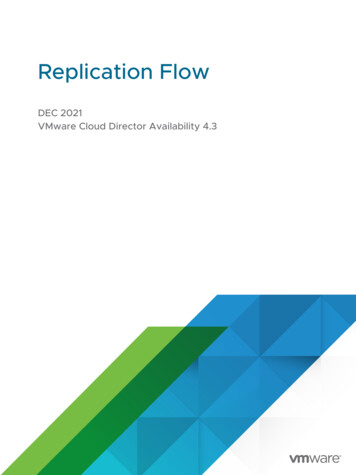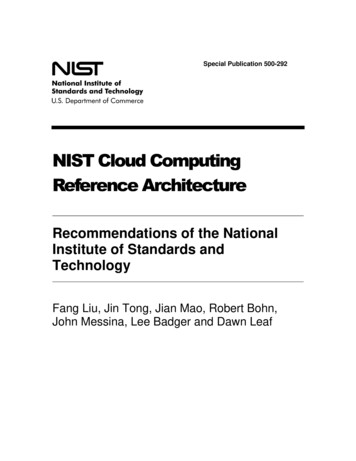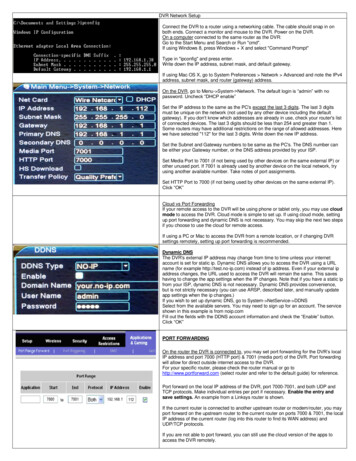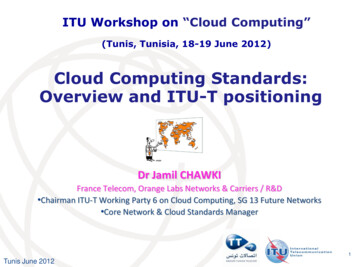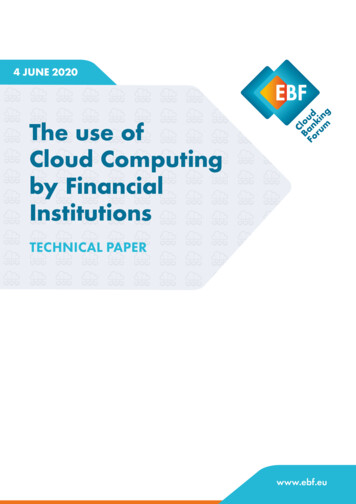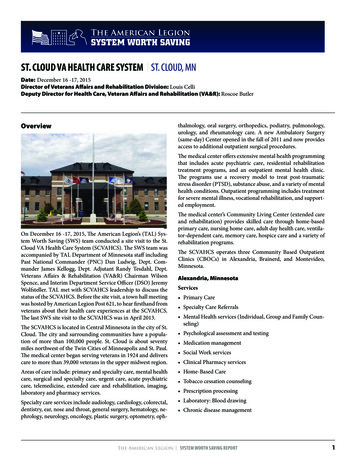
Transcription
The American LegionSYSTEM WORTH SAVINGST. CLOUD VA HEALTH CARE SYSTEM ST. CLOUD, MNDate: December 16 -17, 2015Director of Veterans Affairs and Rehabilitation Division: Louis CelliDeputy Director for Health Care, Veteran Affairs and Rehabilitation (VA&R): Roscoe Butlerthalmology, oral surgery, orthopedics, podiatry, pulmonology,urology, and rheumatology care. A new Ambulatory Surgery(same-day) Center opened in the fall of 2011 and now providesaccess to additional outpatient surgical procedures.OverviewThe medical center offers extensive mental health programmingthat includes acute psychiatric care, residential rehabilitationtreatment programs, and an outpatient mental health clinic.The programs use a recovery model to treat post-traumaticstress disorder (PTSD), substance abuse, and a variety of mentalhealth conditions. Outpatient programming includes treatmentfor severe mental illness, vocational rehabilitation, and supported employment.On December 16 -17, 2015, The American Legion’s (TAL) System Worth Saving (SWS) team conducted a site visit to the St.Cloud VA Health Care System (SCVAHCS). The SWS team wasaccompanied by TAL Department of Minnesota staff includingPast National Commander (PNC) Dan Ludwig, Dept. Commander James Kellogg, Dept. Adjutant Randy Tesdahl, Dept.Veterans Affairs & Rehabilitation (VA&R) Chairman WilsonSpence, and Interim Department Service Officer (DSO) JeremyWolfsteller. TAL met with SCVAHCS leadership to discuss thestatus of the SCVAHCS. Before the site visit, a town hall meetingwas hosted by American Legion Post 621, to hear firsthand fromveterans about their health care experiences at the SCVAHCS.The last SWS site visit to the SCVAHCS was in April 2013.The SCVAHCS is located in Central Minnesota in the city of St.Cloud. The city and surrounding communities have a population of more than 100,000 people. St. Cloud is about seventymiles northwest of the Twin Cities of Minneapolis and St. Paul.The medical center began serving veterans in 1924 and deliverscare to more than 39,000 veterans in the upper midwest region.Areas of care include: primary and specialty care, mental healthcare, surgical and specialty care, urgent care, acute psychiatriccare, telemedicine, extended care and rehabilitation, imaging,laboratory and pharmacy services.Specialty care services include audiology, cardiology, colorectal,dentistry, ear, nose and throat, general surgery, hematology, nephrology, neurology, oncology, plastic surgery, optometry, oph-The medical center’s Community Living Center (extended careand rehabilitation) provides skilled care through home-basedprimary care, nursing home care, adult day health care, ventilator-dependent care, memory care, hospice care and a variety ofrehabilitation programs.The SCVAHCS operates three Community Based OutpatientClinics (CBOCs) in Alexandria, Brainerd, and Montevideo,Minnesota.Alexandria, MinnesotaServices Primary Care Specialty Care Referrals Mental Health services (Individual, Group and Family Counseling) Psychological assessment and testing Medication management Social Work services Clinical Pharmacy services Home-Based Care Tobacco cessation counseling Prescription processing Laboratory: Blood drawing Chronic disease managementThe American Legion SYSTEM WORTH SAVING REPORT1
The American LegionSYSTEM WORTH SAVING Care Coordination for Home Podiatry Services Telehealth classes for diabetes and weight loss Telehealth classes for diabetes and weight lossBrainerd, MinnesotaExecutive Leadership BriefingServicesThe SWS team met with the SCVAHCS Executive Leadershipteam including Barry Bahl, Medical Center Director; Dr. SusanMarkstrom, Chief of Staff; Cheryl Thieschafer, Associate Medical Center Director; and Mark Aberle, Associate Director forNursing/Patient Care Services. Primary Care services Specialty Care Referrals Mental Health services including individual, group and family counseling Psychological assessment and testing Medication management Aging infrastructure, construction, and space: Althoughtheir almost 90-year old buildings are well maintained, manyinternal structures require significant renovation or replacement. Clinics are very crowded and not designed to supportcurrent care delivery models. Multiple construction projectscreate a need for swing space. Additionally, project delays andcost limits are causing much-needed space to in turn be delayed due to necessary domino sequencing. While there is along term plan, they have short-term needs that are increasingly difficult to meet. Social Work services Clinical Pharmacy services Home-Based Care Tobacco cessation counseling Prescription processing Laboratory: Blood drawing Chronic disease management Care Coordination for Home Podiatry Services Telehealth classes for diabetes and weight lossMontevideo, MinnesotaServices Primary Care services Specialty Care Referrals Mental Health services including individual, group and family counseling Psychological assessment and testing Medication management Social Work services Clinical Pharmacy services Home-Based Care Tobacco cessation counseling Prescription processing Laboratory: Blood drawing Chronic disease management Care Coordination for HomeDuring the meeting, the Executive Leadership reported the topchallenges faced by the SCVAHCS: Growth and access to care: SCVAHCS has experienced a 155percent increase in unique patients, growing from 12,111 patients in fiscal 2000 to 38,603 in fiscal 2015. Despite a declining veteran population in the SCVAHCS service area, moreveterans continue to seek care. SCVAHCS experienced patient growth in every year since fiscal 2000, except for fiscal2013, when they experienced a slight decline in the number ofunique patients. This was due to the opening of the NorthwestMetro VA Clinic in Ramsey, MN, (aligned under the Minneapolis VAHCS) which resulted in several thousand patientsshifting care away from St. Cloud. Fiscal 2014 and fiscal 2015 saw the resumption of steadyunique patient growth. Although the increase in enrollmentis a positive thing, the growing demand for services has puta strain on their capacity in many clinics. SCVAHCS utilizesChoice and traditional Non-VA Care Coordination (NVCC)to assist with meeting demand. They also continue to recruitfor providers in primary care, mental health and specialtycare (surgical and medical, all subspecialties) to meet the increased demand internally. They have had difficulty keepingup with demand. Provider Recruitment has been a focus areaand will continue to be for years to come. Succession Planning: The SCVAHCS faces a significant succession challenge along with tremendous competition forskilled health care providers and staff. With 12.7% of the totalworkforce and 17.2% of supervisors projected to be eligibleThe American Legion SYSTEM WORTH SAVING REPORT2
The American LegionSYSTEM WORTH SAVINGfor retirement by 2018, the healthcare system is charged withdeveloping creative and innovative methods of staff development. Less experienced staff may struggle to fill the knowledge vacuum that is created when experienced managersretire. This is especially relevant when it comes to clinicalleaders who are or soon will be retirement eligible. The facility should prepare new Clinical Leaders to ensure a smoothtransition. Work Environment: Fiscal 2014 All Employee Survey revealed that SCVAHCS has system-wide challenges withemployee satisfaction and workplace perceptions. The facility intends to become a safe and productive workplace withsatisfied employees who would recommend SCVAHCS as anexceptional place to work. It is incumbent upon facility leadership to enable this shift toward an excellent work environment. The Fiscal 2015 survey results indicate improvementin employee satisfaction and many other metrics across thehealthcare system. St. Cloud still has work to do, but has madeprogress. Affordable Care Act: The Affordable Care Act provides veterans with new options for health care that will compete withVA services. SCVAHCS should proactively address veterans’questions and concerns, and communicate the benefits associated with VA services to prevent a loss of veterans to theother new options for health care. Veterans Choice Act: The Veterans Choice Act enables veterans who live more than 40 miles from the nearest VA facilityor who have appointment times greater than 30 days out toreceive care in the community. SCVAHCS needs to communicate broadly and clearly to ensure veterans understand theirrights and eligibility. Additionally, the medical center shouldmonitor internal processes and work in close collaborationwith community partners to ensure a smooth transition toand continuation of the new practice. Agency Restructuring: The VA is undergoing a phase of restructuring. It is hard to foresee how the VA will look at theend of all the changes. This uncertainty is challenging to employees and veterans.When asked about what they are doing to ensure that there isopen communication between the medical center, veterans andthe community as a whole, the executive leadership respondedas follows:The SCVAHS maintains a continuous dialog with veterans andthe community through a number of means. They maintaina significant public presence in the news media, hosting twomonthly radio shows in the St. Cloud market area, responding to numerous inquiries and informing the public of activities through frequent press releases. They also maintain a publicwebsite (www.stcloud.gov) and Facebook page (SCVAHSC).For veterans, SCVAHCS publishes an electronic newsletter (Update.) bi-monthly, which is distributed via a self-enrolled listserv accessible via www.stcloud.vs.gov. Veterans visiting theirfacilities are informed via electronic message boards and posterdisplays. Additionally, SCVAHCS also hosts quarterly town hallmeetings. Significant efforts are made to participate in community organizations, and they are members of the St. Cloud,Brainerd, Montevideo and Alexandria Chambers of Commerce.The facility has extensive working relationships within the healthand human services sector in the communities they serve, e.g.the homeless program, vocational rehab, and the Veterans Justice Outreach Program. They also send a representative to thesteering committee for a Veterans Resource Center currentlyplanned by the local St. Cloud Technical and Community College. SCVAHSC has acted upon more feedback than ever beforethanks to the Press Ganey survey responses received from theirveterans. Leadership attends meetings, programs, and conventions organized by internal and external stakeholders to fostercollaboration and ensure that the voice of the veteran is heardand responded to appropriately as much as is possible withintheir power. The director personally attends conferences by theAmerican Legion, Disabled American Veterans, and the Veterans of Foreign Wars.Additionally, SCVAHCS sponsors meetings and programs inthe interest of collaboration, including County Veteran Service Officers, Accredited Representatives quarterly meetings,Veterans Administration Voluntary Service (VAVS) quarterlymeetings, Toastmasters monthly meetings, annual MemorialDay Tribute, annual Veterans Day parade, and annual VeteransRendezvous. In the interest of strengthening relationships, SCVAHSC also maintains a presence at the facility of representatives of the American Legion, Veterans Benefits Administration,and Minnesota Department of Veterans Affairs.In the facility’s strategic plan, the facility identified aging infrastructure, construction, and space as challenges. A significantnumber of patient care buildings are over 90 years old, andmany of the internal structures require significant renovation orreplacement. It was also noted that the clinics are very crowdedand space was not designed to support current care deliverymodels.When asked how SCVAHCS is planning to address these concerns, they responded that SCVAHCS participates in the VA annual capital planning process that consists of the Health CarePlanning Model (HCPM) and Strategic Capital Asset Planning(SCIP) Process. HCPM helps VA Health Care Systems projectdemand in various clinical areas and evaluate alternatives. SCIPis the process through which multi-year business and actionThe American Legion SYSTEM WORTH SAVING REPORT3
The American LegionSYSTEM WORTH SAVINGplans are developed. SCVAHCS has been fortunate in gettingproject approval to meet facility needs. However, the projectsdon’t always occur exactly as planned. SCVAHCS is beginning anew SCIP Cycle developing its fiscal 2018 action plan. Over thenext few months, SCVAHCS will reassess the capital situationand make necessary adjustments to the plan from the past year.ties recruiting primary care and internal medicine physicians.Across the board, HR faces significant challenges in attracting,hiring, and retaining qualified candidates and employees inmission-critical health care occupations. Hiring processes arecomplex and regulations can prevent the most qualified personfrom being hired.Human Resources DepartmentTo ensure positions are filled promptly, SCVAHCS has taken thefollowing actions:As of November 22, 2015, SCVAHCS indicated their authorizedemployee ceiling was 1,722 employees. Of the 1,700 positions,the SCVAHCS reported 143 vacancies. Of the 143 vacancies, 94positions were for physicians, nurse practitioners, physician assistants, dentists, psychiatrists, psychologists to keep consistent,social workers, occupational and physical therapists, registerednurses, advanced practice registered nurses, and licensed practical nurses. Based on the information provided by SCVAHCS,the majority of clinical vacancies identified were in Nursing:Registered Nurse (RN) – 15.1 and Licensed Practical Nurse(LPN) – 14.4, totaling 29.5.During the discussion with Human Resources (HR) staff theSWS team was informed that the processing time to fill a vacantposition varies based on the following variables: Title 5 vs. Hybrid or Title 38 position. If it is a Title 5 position, HR needs to verify if the job description is current orif it requires reclassification. This could add significant time(months) to the timeline. Their mission critical occupations and specialized experiencepositions take longer than entry level or common positions. How the position is announced. Internal positions or thosefilled with a non-competitive hiring authority are filled morequickly than those requiring external vacancy announcements or use of the Delegating Examining Unit. Application significant Veterans Preference. This may create adelay in the final selection if a request to pass over is submitted; minimal qualifications are a low standard. Credentialing requirements. Licensed positions require primary source verification of some items that are dependent onexternal entities to respond timely.There is a National Speed of Hire measure (60 days) that measures the time from when a position is approved to fill to a tentative offer being made. The national speed of hire goal is 80%.Monthly data reflects a fiscal 2015 average of 87.08% for thespeed of hire performance for Title 5 and Title 38. This exceedsthe VISN average of 81.08% for the same period. SCVAHCSquarterly performance was Qtr. 1: 93%, Qtr. 2: 87%, Qtr. 3: 89%and Qtr. 4: 81%.According to HR staff, the SCVAHSC experiences difficul- HR devotes three HR specialists to recruitment and staffingand has further shifted employee relations work from them topermit more dedicated time to post qualifying positions. HR,Office of Information Technology (OIT), and OccupationalHealth work collaboratively to identify and resolve onboarding process delays. SCVAHCS utilizes recruitment incentives as well as a widevariety of hiring flexibilities. A new item was added recently to the HR Officer weeklymeeting: “certificates not returned by selecting officials within30 days to provide visibility of pending selection actions.” Per the Field Guide for the VA’s Enhanced Physician Recruitment and Onboarding Model, the following recommendedpractices already in place: Proactive forecasting of needs Staffing to demonstrated need Backfills authorized as required Pre-approval of recruitment incentive before recruitment Position risk and sensitivity levels determine before recruitment Leveraged increases to the physician pay tables Maximize use of Title 38 hiring authorities Engagement with national recruiter and identification of a facility recruitment liaison; onsite tour coordination and travel Efficient Vet Pro processes Expedited Credentialing Committee Meetings Trained HR technical advisor to the boards In fiscal 2016, SCVAHCS will focus on the following actionswithin the facility or national control: Consistent utilization of WebHR for accurate tracking of approved recruitment action Initial candidate engagement by the Selecting Official with24-48 hours of candidate referral Option to schedule pre-placement physical with provider ofThe American Legion SYSTEM WORTH SAVING REPORT4
The American LegionSYSTEM WORTH SAVINGchoice, including non-VA providerOutpatient Wait Time Results1 Standardize physician and dentist (P&D) assignment coding Linkage of VA Form 10-2850 to autofill within VetPro HR participation in cross-disciplinary training, communication and collaboration with credentialing operationsThe SCVAHCS HR staff denied that the physician pay scale andthe ability to request pay and tier exceptions had been a barrierfor hiring primary care physicians. However, HR staff do runinto issues with some specialty areas and have looked towardspart-time and fee basis appointments to meet those needs. TheNurse Practitioner (NP) and Physician Assistant (PA) specialsalary schedules are reviewed and adjusted annually based onlocal labor market data. This is above and beyond the equivalentGeneral Schedule increase.PendingPrimaryCareCompletedPrimary CarePending Specialty LHEALTHCOMPLETEDMENTALHEALTH6.885.913.34 DaysAt the time of the site visit, the SCVAHCS reported outpatientwait time ( 30 days) in the following clinics:2 Mental Health Compensation and Pension (C&P) – 80.3 days General Internal Medicine - 44.8 daysMedical Center Budget Optometry - 33.1 Ophthalmology - 51.7 days (New Patients only) General Surgery - 39 days (New Patients only) Audiology - 34.4 days (New Patients only) Podiatry - 31 days (Brainerd CBOC New Patients only)The SWS team was informed that the medical center recentlyhired a new psychologist for Mental Health Compensation &Pension (C&P), which should decrease their outpatient waittime for C&P exams.Staff VacanciesBased on the recruitment log that is used by Human Resourcesto track vacant positions, as of December 3rd, 2015, the totalnumber of full-time and part-time vacancies was 143.The top reasons for vacancies were: Competitive recruitment environment for providers Retirements or resignations of current staffNon-VAFY 2015TOTAL OPERATING FUNDS 262,355,087Equipment FundsNon-Recurring Maintenance and Repair FundsConstruction (Headquarters Funded)GRAND TOTAL ALL FUNDS12/2/2015 11,477,048.47 9,907,336.44 1,719,148.39 706,627.97 2,631,486.97 6,527,076.009/30/2014 12,127,090.96 11,953,073.79 2,374,178.38 805,697.33 2,114,755.74 7,930,204.54 2,021,236 11,664,797 1,795,626 277,836,74612/2/2015 13,217,603.97 12,002,975.53 2,369,206.52 770,703.55 2,094,286.77 7,424,430.22FY 2014 232,507,635 6,635,381 3,931,623 8,606,421 251,681,060Authorized OutpatientAuthorized InpatientMill BillUnauthorized OutpatientUnauthorized InpatientHome Care9/30/2013 10,812,659.02 10,098,679.99 1,719,148.39 706,627.97 2,631,486.97 7,815,495.599/30/201512/2/2015 20,058,900.60 12,635,093.69 17,014,921.51 15,984,444.00Total Budget 33,784,097.93 32,968,724.24 37,305,000.74 37,879,206.56 52,610,335.70 40,091,590.31 4,558,000.89 4,478,789.90 10,978,512.70 6,993,262.72 Transfers of current staff to other VA facilities Staff accepting positions outside of the VA system or withinthe facility to other service lines/departments Fiscal 2016 VACA funding for hiring additional providers andsupport staff was initially limited to the amount needed foremployees hired before October 1st, 2015. In the final budget1Source: VHA Access Audit released Nov 19th, 2015 forthe period ending Oct 31st, 20152Source: Pending Appt Cube as of Dec 1, Wait Timesbased on Preferred DateThe American Legion SYSTEM WORTH SAVING REPORT5
The American LegionSYSTEM WORTH SAVINGdistribution, St. Cloud received additional salary funding foremployees hired up to December 2015 with hiring actions inprogress before October 1st. Lower salaries versus private sector Negative VA media coverageThe SCVAHCS HR department developed the facility WorkforceStrategic Succession Plan which included action plans for initiatives that include recruitment and retention in mission criticaloccupations, succession planning pipeline, and employee development.A Recruitment Committee meets monthly and as needed to discuss and plan recruitment events, efforts, advertisement, andstrategies. Additionally, there is a facility Workforce Development Committee which focuses on programs for employee andleadership development. Centrally directed career developmentprograms and successes include:Student (Intern) Program Pathways Internship Program - The health care system utilizes the Pathways Internship Program to provide students theopportunity for employment while going to school and for advancements to higher grades in the federal government. Otherauthorities available under Pathways are the Recent GraduatesProgram and the Presidential Management Fellows Program.Local/VISN Career Development Programs Facility Leadership Development Program - The facilityLeadership Development Program for 2015 selected 14 individuals, and for the 2014 program, 15 people graduated inDecember 2014. Network LEAD Program - Three people from the SCVAHCSwere chosen to participate in the Class of 2012 and 2013 andfour individuals in the Class of 2013 and 2014. Career Ladder Positions: The SCVAHCS continues to announce vacancies under the Merit Promotion Plan at a gradelevel below the full journeyman or target grade. This allowsemployees who would normally not qualify at the target gradelevel to be considered. Non-Title 38 Tuition Funding - This funding is available forstaff in Non-Title 38 positions to continue their education. Infiscal 2015, 62 employees utilized 97,540. Local VA Career Development Program - The objective ofthe program is to provide VA career guidance, Human Resources process information, and tips on career self-development. There were three scheduled offerings of VA Career Dayin fiscal 2015. Two sessions were held with a total of 27 attendees (33 registered), and a third session was canceled dueto registration not meeting the minimum of 12 participants. Itis possible the majority of the employees interested in this typeof program had completed it during fiscal 2014. SCVAHCSwill continue to offer two sessions each fiscal year with a minimum of 12 employees registered. The health care system education programs provide opportunities for continuing education and training. Some examplesof these programs include 7 Habits of Highly Effective People,5 Choices, and the Employee Career Development Program. Chamber Leadership Program - The health care systemsponsored two employees for this local program which develops participants for leadership roles within the community.Education Support Programs National Nursing Education Initiatives Program (NNEI) This program provides opportunities for nurses who do nothave bachelor or masters degrees to return to school to obtaintheir degree. In fiscal 2015, seven participants received benefits from this program valued at 62,140. Employee Incentive Scholarship Program (EISP) - This program provides opportunities for employees to further their education. In fiscal 2015, one participant received benefits fromthis program. Employee Debt Reduction Program (EDRP) - This programis used as a tool to assist in the retention of present employees and as a recruitment incentive for difficult to fill positionswithin the health care system. In fiscal 2015, 11 employeesreceived a total of 150,821 in benefits. This total amount includes those that had service periods that were paid out in fiscal 2015 and those that were approved for fiscal 2015, but theirfirst payout is not until fiscal 2016. Student Loan Repayment Program (SLRP) - The health caresystem utilized VISN SLRP funds to provide up to 10,000 student loan repayments to a total 47 applicants comprised of onehuman resource specialist, 31 LPNs, eight pharmacists, andseven psychologists. Up to 5,000 repayments were awardedto 18 candidates (five medical records techs, one occupationaltherapist, two physical therapists, two health system specialists, seven social workers, and one diagnostic radiologic tech)for a total of 49,8237 in benefits until the funds were withdrawn in mid-fiscal 2015.Facility DemographicsThe SCVAHCS catchment area expands to the following counties: Aitkin, Benton, Big Stone, Cass, Chippewa, Crow Wing,Douglas, Grant, Isanti, Kanabec, Kandiyohi, Lac qui Parle,McLeod, Meeker, Mille Lacs, Morrison, Pope, Redwood, Renville, Sherburne, Stearns, Stevens, Swift, Todd, Wadena, Wright,The American Legion SYSTEM WORTH SAVING REPORT6
The American LegionSYSTEM WORTH SAVINGand Yellow Medicine.SCVAHCS Leadership PrioritiesOperating Beds:SCVAHCS Leadership has expressed the following strategic priorities: Community Living Center (CLC) - 225 Residential Rehabilitation and Treatment Programs (RRTP) 148 Inpatient Mental Health Unit -15Average Daily Census for each Inpatient Programs: Community Living Center (CLC) - 194.4 Residential Rehabilitation and Treatment Programs (RRTP)- 144 Inpatient Mental Health Unit -Acute/Observation Status-7.72Outpatient Encounters:3According to SCVAHCS Business Office staff, they are projectedto see approximately 611,906 Unduplicated Encounters in fiscal 2016. VA projects utilization using the Enrollee Health CareProjection Model (EHCPM), which combines clinic stops, beddays of care, procedures, and others into utilization for variousstrategic planning categories. This is internally consistent anduseful for planning purposes but does not translate well whencompared with historical encounters. However, this model projects an estimated 3.75% increase in utilization for SCVAHCS fiscal 2015-fiscal 2016. Improve access so no veteran has to wait for needed services. Promote a Culture of Excellence and Service among all staff inthe Health Care System. Deliver more than veterans expect through superb customerservice. Increase Operational Effectiveness and Efficiency to make thebest use of the constrained budget. Improve outreach efforts to increase workload and the number of veterans served, thereby securing funding to continueproviding services for future Minnesota veterans. Conduct intensive capital improvements to accommodateexpansive growth and adapt outdated infrastructure to newmodels to deliver high-quality health care.In addition to the centralized planning that occurs throughoutVA and VHA, there are also VISN and Nationwide Service LineStrategic Planning efforts that result in initiatives for the ServiceLines. These link to the larger strategic plan, bringing it to a moreoperational and clinical level. The SCVAHCS has identified thefollowing Service Line Priority Planning Initiatives:Surgical and Specialty Care Service LineUsing historical data from the Veterans Health Administration(VHA) Support Service Center Encounters Cube, SCVAHCSgrew approximately 2.3% from fiscal 2013 to fiscal 2014 and5.7% from fiscal 2014 to fiscal 2015. Since this averages fourpercent, the EHCPM projection of 3.75% seems reasonable. A3.75% growth rate would project SCVAHCS to see 611,906 Unduplicated Encounters in fiscal 2016. 4 Increase veteran access.Strategic Plan Increase surgical case volume and complexity.VHA Strategic Priorities is based on their Blueprint for Excellence, which contains four overarching themes and ten essentialstrategies within those themes. The four overarching themes are: Expand ambulatory surgical procedures offered. Improve Performance Increase the use of students. Increase the use of Telehealth. Increase access to specialty services. Expand Shared Service Center Catalog (SSC) Service LineServices. Increase surgical referrals from VISN 23. Increase the use of technology. Implement the Anesthesia Record Keeping System (ARKS). Promote a Positive Culture of Service Advance Health Care Innovation for Veterans and the Country Increase Operational Effectiveness and Accountability3Source: VSSC Projected Utilization by Parent FacilityBY 2014 Cube4Source: VSSC Encounters Cube Expand simulation training. Develop the Real-Time Electronic Patient Tracking System.Primary and Specialty Medicine Service Line Patient Aligned Care Team (PACT) sustainment Promote personalized, proactive, and patient-driven healthcare.The American Legion SYSTEM WORTH SAVING REPORT7
The American LegionSYSTEM WORTH SAVING Utilize evidence-based care.(CLC) cardiac rehabilitation program (outpatient program). Integrate InterQual in all specialty clinics. Increase the use of E-Health modalities. Increase the use of home telehealth. Increase Clinical Video Telehealth (CVT) including CVT tohome. Increase use of secure messaging. Improve Workload Capture. Veterans Access, Choice, and Accountability Act of 2014 (VACAA) implementation Increase access to primary care providers and specialty providers. Follow implementation guidelines. Continue Development of Step Two – VAHCS Spoke PainConsultation Teams and Programs. Cardiac Rehabilitation Program Physical Therapist in CBOC Support Re
The medical center's Community Living Center (extended care and rehabilitation) provides skilled care through home-based primary care, nursing home care, adult day health care, ventila-tor-dependent care, memory care, hospice care and a variety of rehabilitation programs. The SCVAHCS operates three Community Based Outpatient


